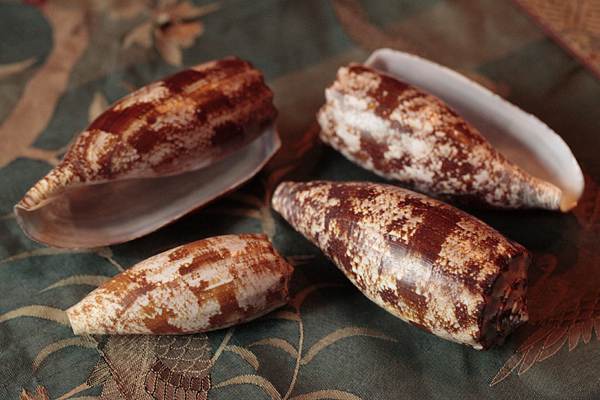
"O death, where is thy sting?"
I Corinthians 15:55
Although most cone snails feed on marine worms and other mollusks, approximately ten percent are piscivorous and hunt fish, as Kohn was the first to report in 1956, when he observed a Conus striatus in an aquarium paralyze its prey by "apparently a powerful neurotoxin." This conotoxin is synthesized in a long convoluted venom duct connected to a muscular bulb that ejects the venom through a hollow harpoon-like barb held by the proboscis, much like a disposable hypodermic needle. A struggling fish is immobilized within one or two seconds, quickly enough that it cannot escape or injure the cone snail itself.
The first study of cone snail envenomation was conducted in 1932 by Hermitte, who reported on a patient in the Seychelles Islands in the Indian Ocean who had been stung by a C. geographus ("Geography Cone") while holding it in his hand, scraping the shell with a knife. Within an hour, the patient's body was completely numb and even nine hours later he still was unable to stand. Curious that a creature measuring less than three-and-a-half inches could completely incapacitate a healthy adult male, Hermitte dissected the snail and discovered a radular tooth protruding from the proboscis, the poison itself produced in the coiled poison duct of the animal. Reviewing incidents of cone stings from 1848 (when an injury from C. aulicus was noted) to 1943, including the summary published that year by Clench and Kondo, Hermitte noted five human fatalities: three by C. geographus and two by C. textile ("Textile Cone").
Olivera has compared the neuromuscular effect of its sting to being bitten by a cobra while eating fugu, the Japanese blowfish. Death usually occurs through paralysis of the diaphragm or cardiac failure. Given the complex array of peptides in conotoxins, there is no antivenin and, other than artificial respiration and the possible administration of an acetylcholinesterase inhibitor (which prevents the enzyme from breaking down acetylcholine, the neurotransmitter that conducts nerve impulses), no specific treatment but to keep the victim alive until symptoms abate, which can take from hours to weeks.
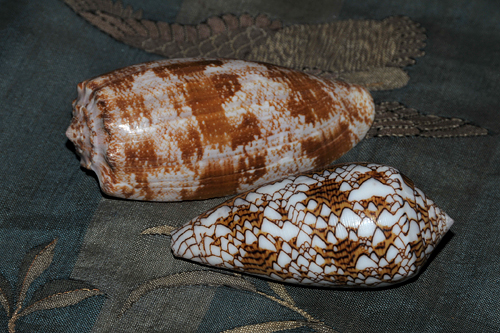
The venom that is so lethal to fish also is a potential threat to humans. Stings from a dozen or so cone species have been recorded, but actual deaths have been attributed to only two: C. geographus and C. textile. In 1963, Kohn reported thirty-seven cases of stings by cone shells and ten deaths, half of which were inflicted by C. geographus and two by C. textile (the remaining three were unidentified). Almost twenty years later, Yoshiba recorded twenty-one deaths, eighteen caused by C. geographus, the sting of which was fatal two-thirds of the time, and two by C. textile.
Given the description of the shell, the death reported by Rumphius in 1705 (the first account of a Conus envenomation) may very well have been by C. textile. In a report by Gill in 1876, it was "believed" to have been responsible for a second fatality in 1860. But the death of the islander, who "in the doubtful light...took a good-sized shell-fish and put it in his basket," now is thought to have been caused by C. geographus. Indeed, in a personal communication, Kohn, who maintains a database of cone envenomations, had recorded thirty-three human fatalities by 2009, "all probably due to C. geographus." In 2016, he published a comprehensive review of cone snail fatalities and counted thirty-six deaths, thirty-one from the sting of C. geographus.
In 1935, a man died within five hours after having been stung by a C. geographus. The injected conotoxin that killed him has been calculated by Dutertre to have been between 0.029–0.038 mg/kg. This death was the first well-documented case to be reported in the literature, the most prominent by Hugo Flecker, who is better known for his study of Chironex fleckeri, a large species of box jellyfish that truly is one of the world's most venomous creatures. Another envenomation by C. geographus that year in Okinawa proved fatal within three or four hours, and in 1964 there was a death within two hours. (These latter two cones were considerably larger than the first.)
Yoshiba estimated a lethal dose of conotoxin in humans to be from 0.001–0.003 mg/kg (1–3 µg/kg) in amounts corresponding to LD70 in humans. This is the dose, measured in milligrams per unit of body weight, that kills 70% of those envenomated. In two cases, just 0.2–0.5 µg/kg of conotoxin resulted in severe paralysis. Other accounts, however, have indicated a LD50 (a lethal dose that causes death in 50% of cases) from 0.012–0.030 mg/kg. The U.S. Army has calculated the LD50 of conotoxins to be 0.005 mg/kg (acontine, the topic that initiated this discussion, has a LD50 of 0.1 mg/kg). Dutertre et al. attribute Yoshiba's exceedingly low amounts to his assertion that the amount of venom injected was only that contained within the radular tooth when, in fact, the volume likely is determined by the amount available.
If potentially deadly, envenomations by C. geographus also are extremely rare, with only three dozen deaths recorded in three hundred years. By comparison, there are twenty to fifty fatalities annually in the United States from the stings of bees and wasps alone.
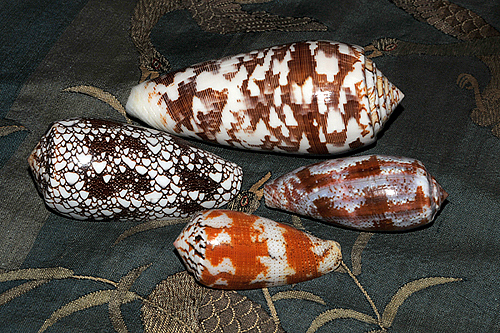
Additionally, Kohn has recorded near fatalities and severe cases of envenomation by C. geographus (3) and C. textile (1), as well as by C. omaria (1) and C. tulipa (3). In a study of the venoms of approximately three dozen cone species, Endean and Rudkin determined that the smaller C. tulipa was second only to C. geographus in the danger presented to humans and ranked the species as follows: C. geographus > C. tulipa > C. magus > C. striatus. Pictured above from top to bottom are C. striatus, C. omaria, C. tulipa, and C. magus.
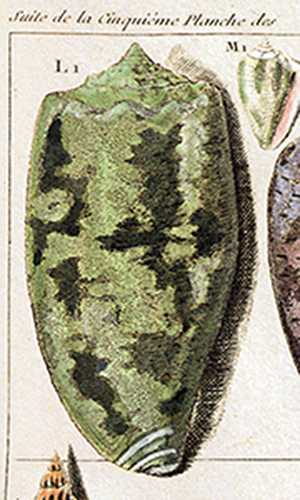
Johnson and Stablum were the first to observe that, unlike most piscivorous cones, which hunt by extending their proboscis until it comes into contact with the fish, C. geographus opens its mouth and distends it like a net. During this time, the fish is completely quiescent, which suggests that a narcotizing or anesthetizing agent has been released into the water. It is only after the rostrum (rhynchodaeum) of the mollusk has extended over the prey that it is stung and then engulfed completely. But when the shell itself was touched, the rostrum did not dilate as it would have been during feeding. Instead, only the proboscis was extended, which suggests that the venom of C. geographus is used primarily for defense. Indeed, only 15 to 20 of its 100–200 peptides are used to capture prey. The others are used for defense against predators as well as other competitors for food. This imaginatively colored depiction of C. geographus is from d'Argenville's La Conchyliologie (1765, 3rd ed.)
Like cone shells, the North Australian box jellyfish or Sea Wasp must kill its prey (shrimp and small fish) almost immediately if the delicate tentacles, which can number as many as sixty and stretch ten feet in length, are not to be damaged. Primitive eyes (black dots on the sides of the box-shaped body, each containing six eyes, two of which have sophisticated optics) help the jellyfish to avoid obstacles and, since it can actively swim, possibly to hunt. When there is contact, millions of specialized stinging cells (nematocysts) contained in the tentacles are fired within milliseconds of being triggered, each injecting a minute amount of venom directly into the bloodstream in what is thought to be the most rapid envenomation process known. The excruciating pain is enough to put the victim into immediate and often fatal shock, with death from respiratory or cardiac arrest occurring in less than five minutes.
Since the first reported case in 1883, there have been at least seventy-seven deaths in Australia alone from jellyfish stings, mostly of children. The organism responsible for virtually all of these fatalities was not identified until 1955, when a five-year-old boy died after being stung in shallow water. Flecker suggested that the site be netted and several box-shaped jellyfish were caught. Sent to Ronald Southcott who, while serving as a medical officer during World War II, had himself observed differences in stings, they were identified as a new genus and species, which he named Chironex fleckeri in honor of his colleague.
Another much smaller jellyfish inhabits the water off the shores of northern Queensland, and even this tiny creature has been responsible for several human fatalities. Before either perpetrator had been identified, both Southcott and Flecker recognized that two type of stings were being inflicted: stripes of vivid wheals or a simple puncture mark. This latter sensation was like a wasp sting or might not even be felt at the time. Within twenty or thirty minutes, however, there was shock, nausea and painful retching and vomiting, severe cramps and intense muscle spasms—all possibly stimulated by the excessive release of catecholamines (adrenaline and noradrenaline). In a brief letter to the Medical Journal of Australia in 1952, Flecker proposed that these symptoms, which Southcott had termed "Type A" stings, be called the "Irukandji sting" after a local aboriginal tribe that once had inhabited the area of Cairns, where most incidents had occurred.
Flecker died in 1957, not having learned the cause of this mysterious syndrome. But work was continued by Jack Barnes, who surmised that, whatever the agent, it must be virtually invisible not to have been seen before. During the beginning of summer in 1961 (December in the Southern Hemisphere), he eventually caught two jellyfish the size of a thumbnail, colorless and almost transparent. To induce the Irukandji syndrome and so conclusively determine its cause, he deliberately allowed his eager nine-year-old son to be stung, then himself and a robust local lifeguard—the questionable experiment sending them all to the hospital. Barnes reported his findings in 1964, and Southcott subsequently named the new species Carukia barnesi after the intrepid doctor.
The genus Chironex derives its scientific name from the Greek cheiro, meaning "hand," and the Latin nex, "murder." (Chiron, the centaur in Greek mythology who was skilled in medicine and the mentor of Asclepius, has the same etymology.) Carukia is a combination of Carybdea (the family to which the jellyfish belongs) and Irukcandji, which still is its popular name.
Flecker provides the first well-documented report of a cone sting fatality, which can serve as a case study of the effect of conotoxin. In June 1935, while on a pleasure cruise off the northeastern shore of Queensland, a twenty-seven year old man landed at Hayman Island (one of the Whitsundays), where he picked up a live C. geographus and, holding it in his palm, proceeded to clean it with his knife. Pricked by the barb of the mollusk, his hand almost immediately became numb. Ten minutes later, there was a feeling of stiffness of the lips; after twenty minutes, his sight became blurred; after thirty, his legs were paralyzed; and within the hour, the man became unconscious and slipped into a deep coma with a weak and rapid pulse, and slow, shallow respiration. Five hours after having been stung, he was dead. The shell that killed him now is in the collection of the Queensland Museum).
Coincidently, a potentially fatal sting from a cone shell (and one of the most recent to be recorded) occurred eighty years later, in June 2015, when a twenty-five year old man stepped barefoot on a cone in Tongue Bay, Whitsunday Island approximately fifteen miles to the south in the same island chain. The reaction was the same: the pain creeping from his foot to his knee and then the whole body. Within another fifteen minutes, the pain was so excruciating that the victim went into convulsions, which spread the venom throughout his body and he began to lose consciousness before being airlifted to a hospital.
More than three centuries earlier, Rumphius had written of the Portuguese Man of War (Physalia pysalis, from the Latin for "bladder, bubble"), a jellyfish-like creature that, much like the box jelly, can cause painful, even fatal stings.
"Their [the tentacles] color is a beautiful blue, but always with a hint of green. They are very fragile and easily break off and remain hanging from whatever touched them, causing a dire burning and pain; wherever they touch, the skin turns red and becomes covered with blains; indeed, the entire side of the body will be filled with pain where it has been touched by them."
The Ambonese Curiosity Cabinet (I.42, p. 78)
Chironex and Carukia both are portmanteau words, in which parts of two words are combined to form a single new one. The definition comes from Lewis Carroll's Through the Looking Glass, where Humpty Dumpty tries to explain to Alice the meaning of such words in the Jabberwocky. "You see it's like a portmanteau—there are two meanings packed up into one word." A portmanteau is a trunk or large suitcase with separate compartments for hanging clothes and folding them. Satisfyingly, "portmanteau" is itself a portmanteau, joining two French words: porter (carry) and manteau (a cloak or mantle).
Ogden Nash teases Carroll in a nonsense poem of his own—
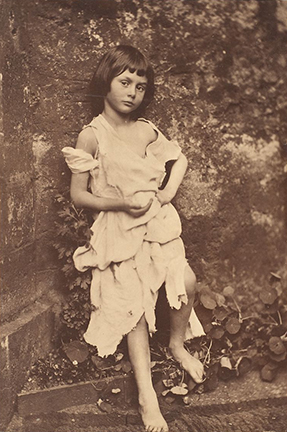
"Said Lewis Carroll to Alice
Liddell,
'Gee, little girl, I think you're swell.
You're so light that I can carry you,
You know, I think I'd like to marry you!'
Said Alice Liddell to Lewis
Carroll,
'I'm afraid that you are over a barrel,
You might think wedlock would be heaven,
But you forget I'm just eleven.'
And Lewis said, 'Tut, tut, a shame!
But wait! Instead, I'll put your name
In my new book. Won't that be grand?'
Ergo: 'Alice in Wonderland.'"
References: "Injuries and Diseases of Man in Australia Attributable to Animals (Except Insects)" (1912) by J. B. Cleland, Australasian Medical Gazette, 32(11), 269-274 and 32(12), 295-299; "Venomous Marine Molluscs of the Genus Conus" (1946) by L. C. D. Hermitte, Transactions of the Royal Society of Tropical Medicine and Hygiene, 39(6), 485-512; "The Poison Cone Shell" (1943) by William J. Clench and Yoshio Kondo, American Journal of Tropical Medicine, 23, 105-122; "Cone Shell Mollusc Poisoning, with Report of a Fatal Case" (1936) by H. Flecker, The Medical Journal of Australia, 1, 464-466; "Piscivorous Gastropods of the Genus Conus" (1956) by A. J. Kohn, Proceedings of the National Academy of Sciences, 42(3), 168-171; "Venomous Marine Snails of the Genus Conus" (1963) by A. J. Kohn, in Venomous and Poisonous Animals and Noxious Plants of the Pacific Area edited by Hugh L. Keegan and W. V. Macfarlane; Poisonous Gastropods of the Conidae Family Found in New Caledonia and the Indo-Pacific (1965) by René Sarramegna; "Conus Venom Peptides: Reflections from the Biology of Clades and Species" (2002) by Baldomero M. Olivera, Annual Review of Ecology and Systematics, 33, 25-47; "Conus Peptides, Pt.1" (May 2006) by Baldomero Olivera, The American Society for Cell Biology (online iBioSeminars); "Clinical Toxicology of Conus Snail Stings" (1995) by Lourdes J. Cruz and Julian White, in Handbook of Clinical Toxicology of Animal Venoms and Poisons edited by Jürg Meier and Julian White; "Further Studies of the Venoms of Conidae" (1965) by R. Endean and Clare Rudkin, Toxicon, 2, 225-249; "An Estimation of the Most Dangerous Species of Cone Shell, Conus (Gastridium) geographus Linne, 1758, Venom's Lethal Dose in Humans" (1984) by Shigeo Yoshiba, Japanese Journal of Hygiene, 39, 565-572 (in Japanese); "Cone Shell Stings: Recent Cases of Human Injury Due to Venomous Marine Snails of the Genus Conus" (1958) by Alan J. Kohn, Hawaii Medical Journal, 17(6), 528-532; The Conus Biodiversity Website (Alan J. Kohn, Principal Investigator); "Observations on the Feeding Behavior of Conus geographus (Gastropoda: Toxoglossa)" (1971) by Clifford Ray Johnson and William Stablum, Pacific Science, 25, 109-111; Antoine-Joseph Dezallier d'Argenville: Shells (2009) by Veronica Carpita, Rainer Willmann, and Sophia Willmann; The Ambonese Curiosity Cabinet: Georgius Eberhardus Rumphius (1999) translated by E. M. Beekman; USAMRIID's Medical Management of Biological Casualties Handbook (Appendix I: Comparative Lethality) (2004) by the U.S. Army Medical Research Institute of Infectious Diseases; Life in the Southern isles; or, Scenes and Incidents in the South Pacific and New Guinea (1876) by William Wyatt Gill; "Dangerous Australian Box Jellyfish" (2005) by Peter J. Fenner, South Pacific Underwater Medicine Society Journal, 35(2), 76-83; "Australia's Box Jellyfish: A Killer Down Under" (1994, August) by William M. Hamner, National Geographic, 186(2), 116-130; "Evolution of Separate Predation- and Defence-Evoked Venoms in Carnivorous Cone Snails" (2014) by Sébastien Dutertre, Ai-Hua Jin, Irina Vetter et al., Nature Communications, 5(3521); "Human Injuries and Fatalities due to Venomous Marine Snails of the Family Conidae" (2016) by Alan J. Kohn, International Journal of Clinical Pharmacology and Therapeutics, 54(7), 524-538; "Deadly cone shell agony: 'I was convulsing in pain,'" The Daily Mercury (Mackay, Queensland), June 11, 2015; "Intraspecific Variations in Conus Geographus Defence-Evoked Venom and Estimation of the Human Lethal Dose" (2014) by Sėbastien Dutertre, Ai-Hua Jin, Paul F. Alewood et al., Toxicon, 91, 135-144 (from which the picture of the Queensland shell has been taken); "Worldwide Deaths and Severe Envenomation from Jellyfish Stings" (1996) by Peter J. Fenner and John A. Williamson, Medical Journal of Australia, 165(11), 658-661; "Cause and Effect in Irukandji Stingings" (1964) by J. H. Barnes, Medical Journal of Australia, 1(24), 897-904; "Box Jellyfish and Irukandji Deaths in Australia" (n.d.) by Lisa-ann Gershwin, Australian Marine Stinger Advisory Services (online database); "Killers in Paradise" (2005, June) by Paul Raffaele, Smithsonian Magazine; "Fatal Stings to North Queensland Bathers" (1952) by H. Flecker, Medical Journal of Australia, 1(13), 458; "Irukandji Sting to North Queensland Bathers Without Production of Weals But With Severe General Symptoms" (1952) by H. Flecker, Medical Journal of Australia, 2(3), 89-91; "Studies on Australian Cubomedusae, Including a New Genus and Species Apparently Harmful to Man" (1956) by R. V. Southcott, Australian Journal of Marine and Freshwater Research, 7(2), 254-280; "Revision of some Carybdeidae (Scyphozoa: Cubomedusae), Including a Description of the Jellyfish Responsible for the 'Irukandji Syndrome'" (1967) by R. V. Southcott, Australian Journal of Zoology,15, 651–671; Ogden Nash's poem has been taken from "Words Going Wild," a blog by Jim Bernhard; "Cardiovascular Actions of the Venom from the Irukandji (Carukia barnesi) Jellyfish: Effects in Human, Rat and Guinea-Pig Tissues in Vitro and in Pigs in Vivo" (2005) by Kenneth D. Winkel, James Tibballs, Peter Molenaar, et al., Clinical and Experimental Pharmacology and Physiology, 32(9), 777-788; "Advanced Optics in a Jellyfish Eye" (2005) by Dan-E. Nilsson, Lars Gislén, Melissa M. Coates, et al., Nature, 435(7039), 201-205.